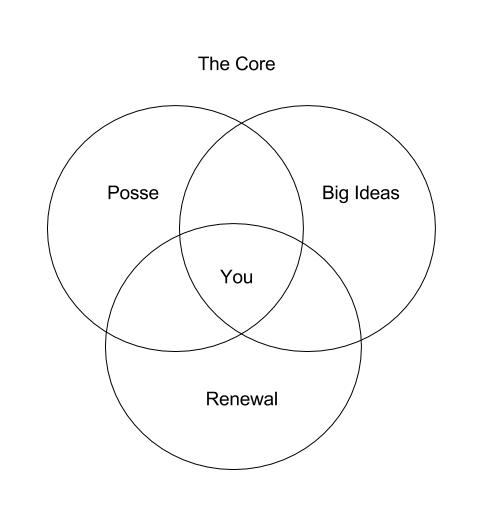
Networking For When It’s All Too Hard
5th Apr 2016A lot of people say that networking is hard, and they’re not good at it. And, we know (or at least, we hear) that a healthy network is good for us. So there’s this tension that we live with. If you’re one of those people feeling that tension, let me help you ease the pain.
If you want to know how to build and sustain a useful network, and you read nothing else, just act on these two ideas:
- Keep a few key people close.
- Find simple ways to add value to everyone else.
Let’s pick those apart:
Many believe that our networks have to be based on two-way, reciprocal relationships. But do they? With everyone, all of the time? That sounds like a lot of hard work.
Think of it like this:

Here’s the idea: we all need relationships that are based on trust and reciprocity. But we probably don’t need that many deep ones. It might be no more than 5-10 people. Borrowing from Lynda Gratton at the London Business School, we need three types of ‘core’ networks:

- Our ‘Posse’: people who do the same type of work as us and can help us with operational, day-to-day challenges. We can call them up to get answers or ideas. They get our world, we get theirs. Stuff runs smoother with them than without them.
- Our ‘Big Ideas’ network: these are the people who don’t do the same work as us. In fact, it’s better if they’re in a completely different industry, country, or culture. Their value is in their difference to our world, not in their similarities. They can provide different perspectives, bring fresh thinking, help us see new opportunities and connect more dots.
- Our ‘Renewal’ network: people who we can just hang out and have a drink with, let off steam, enjoy talking about life, and we feel good during the process. Good for the soul, these people.
The Venn shows us that one or more core roles can reside in one person. And our relationships here are interdependent. They’re based on two-way trust and reciprocity – you give to them, they give to you. And at the same time, the circles don’t fully overlap: you don’t get all of your relationship needs met with one person, and you’re not everything to them either.

The good news is that you’ve likely already got a network that’s made up of these people.
If you put most of your relationship-building time and effort into The Core, you are pretty much sorted. For more on how your core network can look, and how to build it, check out my post on Networked Leadership.
But what about Everyone Else? Don’t they matter? Of course they do. Everyone Else includes those people whom you believe it’s important to be connected to in some way, even though there might not be any obvious or immediate payoff. They might include people you want to influence or help in some way (customers, senior decision makers, etc.) and / or those you’ve made a connection with on LinkedIn, Facebook, Twitter and the like. They’re not core, but they’re important nonetheless.
Everyone Else is a bigger number than the core. Too big to maintain deep, reciprocal relationships with everyone, all of the time. Often, we can feel a pressure to maintain these relationships, and that’s where it all seems too hard.
And, yet, there’s huge opportunity here. The opportunity to add value, while growing your reputation as someone who cares, and makes a difference.
Do this by sharing things or ideas that you think people will find useful. Go one-way. Pay it forward. Do it regularly, thoughtfully, and without expecting anything back. And what you will (most likely) get back is a perception that you are helpful, interested and therefore worth knowing. No guarantees, of course, but in my experience the law of karma plays out over time.

Some thoughts about how you can add value to Everyone Else:
- Buy them a coffee and listen well
- Share a quote, an article, a podcast, a video
- Introduce them to someone you think can help them
- Give a talk or teach a class
- Write an article or blog post
And some final thoughts:
- Take a leaf out of Toastmasters’ book: when you’re sharing an idea, decide whether your intent is to be Educational, Inspiring or Entertaining.
- Frequency will depend on your capacity and their needs and preferences. I work on roughly a monthly rhythm – I aim to share something valuable with Everyone Else once per month.
- There are subsets to Everyone Else – think about what natural groupings people fall into. I share different stuff on LinkedIn (my professional network) than I do on Facebook (my personal contacts).
Pareto got it right with the 80/20 rule. Focus 80% of your efforts on 20% of the people, and vice versa. And then find simple ways to add value to everyone else.
Like this post? You’re only getting half the story. Sign up to my ‘Fresh Thinking’ newsletter, delivered monthly to your inbox.


3 thoughts on “Networking For When It’s All Too Hard”
Comments are closed.